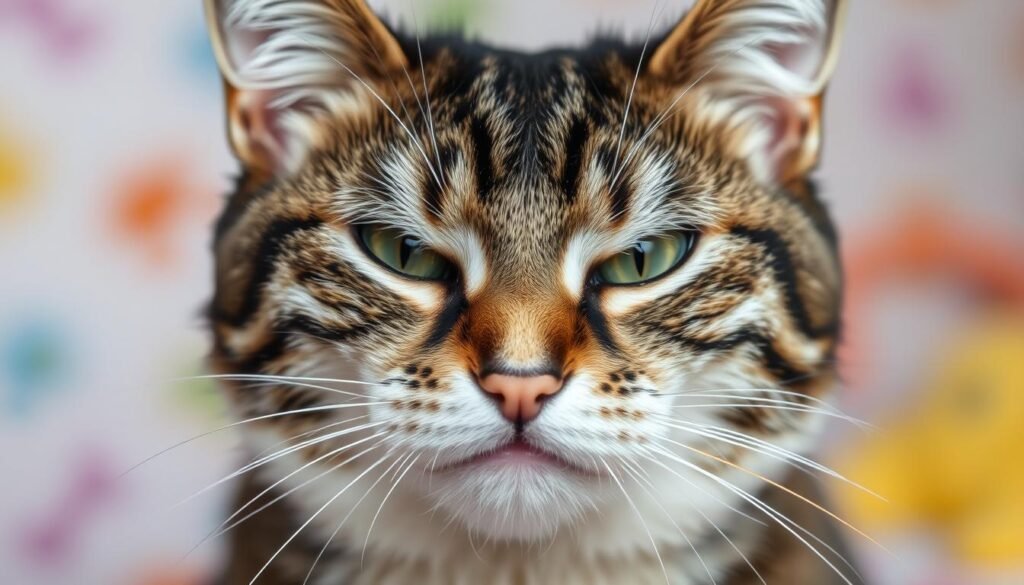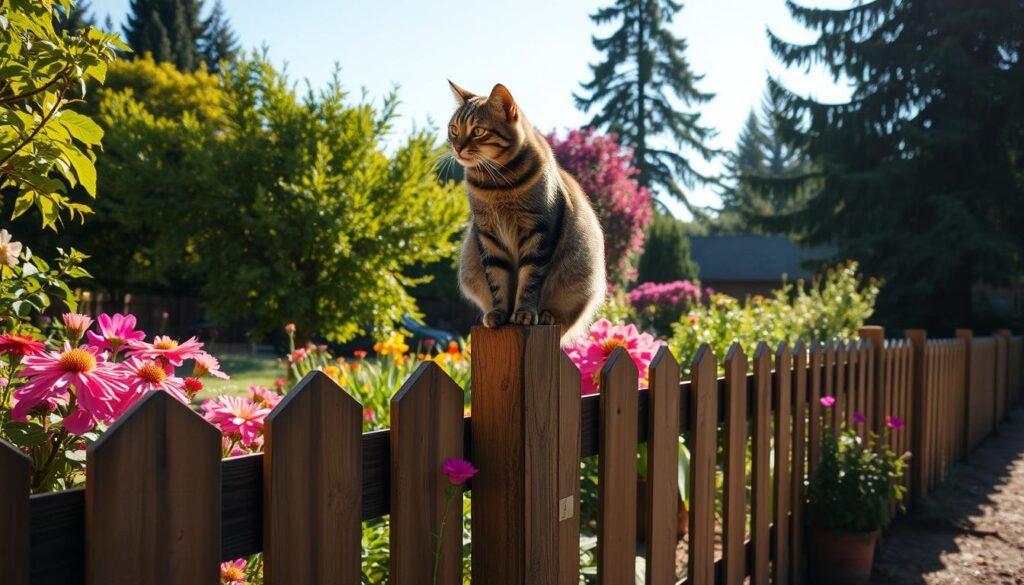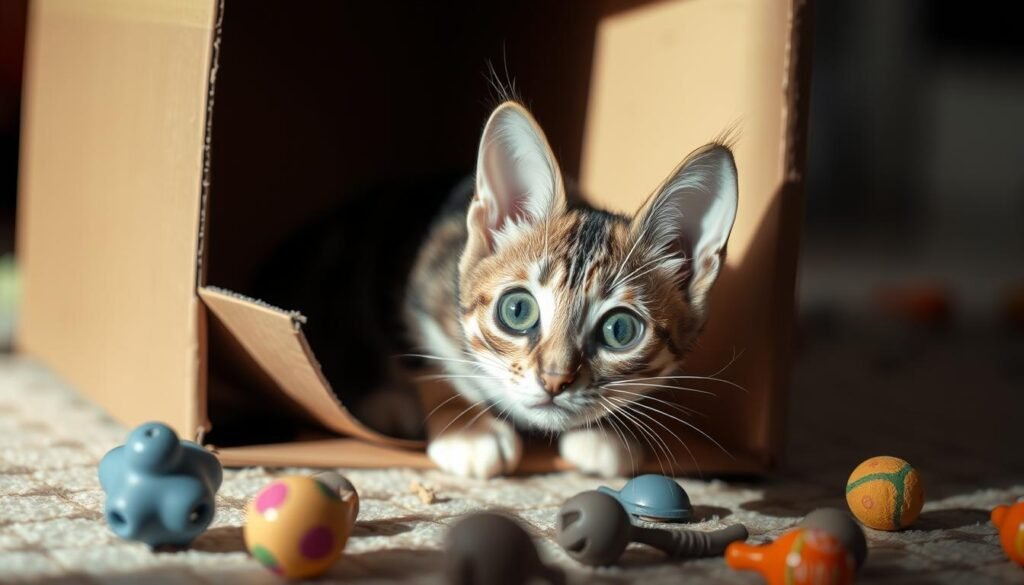The Great Cucumber Mystery: Why Do Cats Fear Them?
Have you ever seen a cat’s reaction to a cucumber? It’s a sight to behold. These usually calm and collected creatures can suddenly become terrified of this seemingly harmless vegetable. Why is that?
Let’s dive into the world of feline behavior and try to figure out this puzzling phenomenon.

The Cucumber Conundrum: Why Cats Fear This Simple Vegetable
Cats are known for their mysterious and often quirky behaviors. One of the most viral cat-related phenomena is their fear of cucumbers. Videos of cats jumping, hissing, or backing away from these seemingly harmless vegetables have flooded the internet.
So what’s the reason behind this peculiar fear? Experts believe it’s primarily due to the sudden appearance of something unfamiliar. The cucumber’s elongated shape might trigger a startle response in some cats, especially if it appears unexpectedly. It’s important to note that this fear isn’t necessarily related to any specific phobia or a mistaken identification of the cucumber as a snake. Cats’ heightened senses and sensitivity to change can contribute to their dramatic reactions.
The Curious Case of Cats and Cucumbers
Viral videos of cats reacting to cucumbers have amazed people everywhere. These videos have sparked a lot of interest in why cats might be scared of cucumbers. It’s a mystery that has caught the attention of many.
Viral Videos: Felines Freaking Out
Many cat owners have shared videos of their pets acting strangely when a cucumber is placed behind them. These videos have become very popular, making people laugh and wonder why cats react this way. They have also led to a deeper look into cat behavior, feline fears, and anxiety triggers.
Understanding Cat Behavior: Fear and Anxiety
Experts believe that cats’ reactions to cucumbers are because of their sharp senses and fear of new things. Cats are naturally alert to dangers, and a sudden cucumber can scare them. Their acute hearing and keen visual perception help them notice even small changes.
“Cats are highly sensitive creatures, and their anxiety triggers can range from loud noises to unexpected changes in their surroundings. The viral videos of cats reacting to cucumbers shed light on the complex world of feline behavior and the importance of understanding our feline companions’ unique needs and sensitivities.”
Why Do Cats Get Scared?
Cats are natural survivors. Their fear of things like cucumbers comes from their instincts and survival skills. These skills help them detect threats, a trait passed down through generations.
Evolutionary Instincts and Survival Mechanisms
Cats are very aware of their surroundings. Their cat fears come from needing to watch out for predators and new things. Their evolutionary instincts give them sharp senses to spot and react to changes and new objects. This helps keep them safe in the wild.
Environmental Changes and Novel Objects
New items, like cucumbers, can scare cats because they see them as threats. Their sensitivity to new things is a key survival skill. It helps them react fast to dangers.
“Cats are territorial animals that rely on the element of surprise for a successful hunt and prefer observing their environment from a tall position.”
The funny videos of cats reacting to cucumbers show their complex nature. It’s about their evolutionary instincts, survival mechanisms, and how they handle new things.
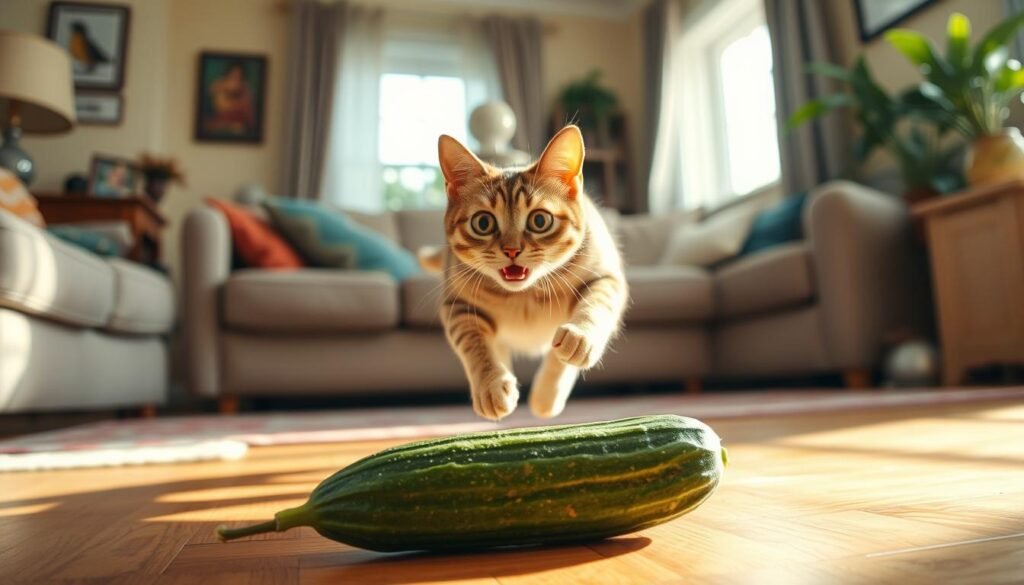
Cats vs. Cucumbers: The Unexpected Phobia Explained
Cats get startled by cucumbers because of their sharp senses and instincts. They can see, hear, and smell things that others can’t. When a cucumber appears suddenly, it looks like a threat to them.
Mistaken Identity: Cucumber or Snake?
Some think cats might think cucumbers are snakes, which scares them. But cats are good at hunting snakes. It’s more likely they just get surprised by the new object.
The science of cat reactions to surprises is linked to their evolutionary instincts. Cats have sharp senses and quick reflexes to stay safe. The cucumber vs. snake debate shows how complex cat psychology is.
“Cats have a keen sense of sight, hearing, and smell, which allows them to detect even the slightest changes in their surroundings.”
Other Common Feline Fears and Anxieties
Cucumbers aren’t the only thing that scares our cats. They have many fears and anxieties. This is because of their sharp senses and need for safety and familiarity. Knowing what scares cats can help us make them feel safe at home.
Loud Noises and Unfamiliar Sounds
Cats get scared easily by loud sounds like fireworks or vacuum cleaners. Their ears can pick up sounds up to 60,000 Hz. This makes them very sensitive to new and loud noises. Helping them feel safe can reduce their anxiety.
Strangers and New Environments
New people, pets, or things in their space can scare cats. They like things to stay the same and feel secure. Giving them a safe place and slowly introducing new things can help them adjust.
It’s important to know what scares our cats. By making their environment safe and comfortable, we can help them feel secure. This reduces their fear of loud noises, unfamiliar sounds, new environments, and strangers.
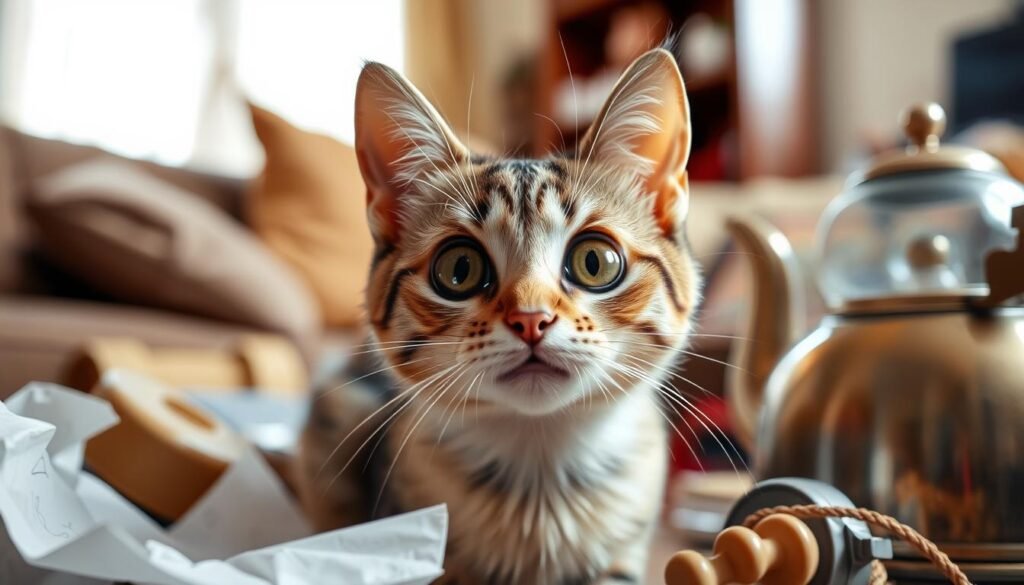
“Cats are known to thrive on routine, and the unexpected introduction of a cucumber can disrupt their sense of security.”
Preventing Fear and Anxiety in Cats
Keeping our feline friends happy and stress-free is a top priority for responsible cat owners. There are several effective strategies to help prevent fear and anxiety in our furry companions. Early socialization and desensitization, along with creating a secure and comfortable home environment, are key.
Early Socialization and Desensitization
Introducing kittens to various sights, sounds, and experiences from a young age is crucial. This early exposure helps them become more resilient and adaptable. It reduces the chance of developing debilitating fears later in life.
Gradually exposing cats to potentially frightening objects, like vacuum cleaners or new people, while providing positive reinforcement is also helpful. This approach helps them overcome their anxieties.
Creating Safe Spaces and Hiding Spots
Providing cats with designated safe spaces and hiding spots within their home environment is essential. These areas offer them a sense of security and comfort, reducing stress-induced behaviors. Cats often feel more at ease when they have access to cozy, enclosed areas where they can retreat and feel protected.

“Preventing fear and anxiety in cats is crucial for their overall well-being and happiness. By addressing these needs early on, we can help our furry companions thrive and enjoy their lives to the fullest.”
Dealing with a Startled Cat
When a cat gets startled, it’s important to know how to react. Look for signs like hiding, too much grooming, or changes in eating or activity. A quiet, clean space and respecting the cat’s space are key.
Signs of Stress and Anxiety
A study found that 58% of cat owners think their cats get stressed. Changes in eating habits were a big sign in 72% of stressed or sick cats. This is something cat owners should watch for.
The FAS (Fear, Anxiety, and Stress) scale shows different levels of stress. 60% of cases showed yellow signs (FAS 2-3), 30% red signs (FAS 5 and 4), and 10% green signs (FAS 0-1). Changes in the environment or new family members were common stressors. Health issues also played a part in 25% of cases.
Calming Techniques and Remedies
Comfort and stimulation, like toys or puzzles, can help calm a startled cat. There are also calming techniques and remedies, like synthetic pheromones or supplements, to ease anxiety and fear. Creating a safe space and sticking to a routine were effective in 70% and 80% of cases, respectively. Sometimes, a vet’s advice is needed in 50% of ongoing stress cases.
Understanding stress and anxiety signs in cats and using the right calming methods can help. This way, pet owners can support their cats during scary moments and keep them happy and healthy.
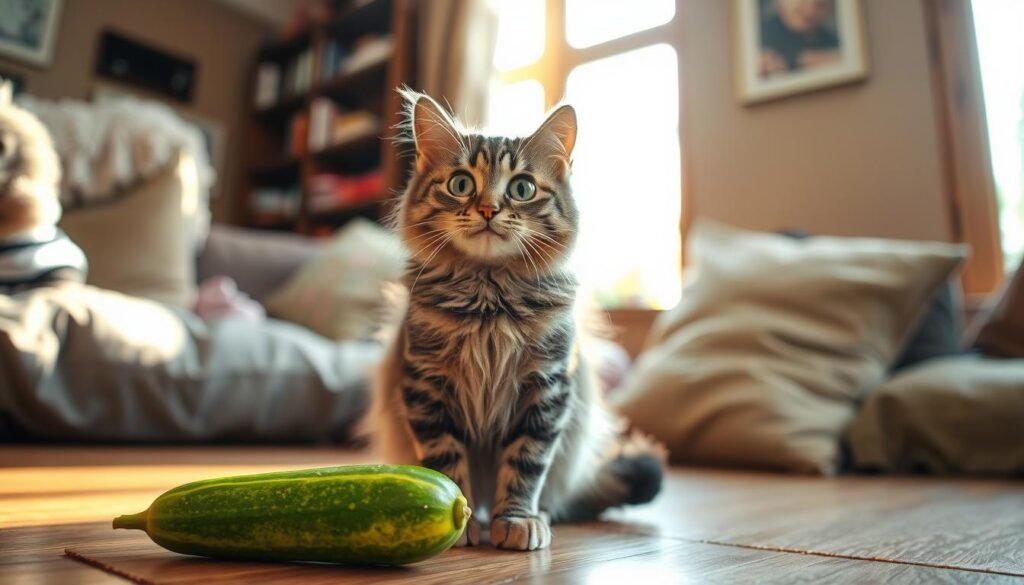
The Viral Cucumber Prank: Ethical Considerations
The viral videos of cats reacting to cucumbers have caught everyone’s eye. But we must think about the ethical considerations of this “cucumber prank.” Scaring cats for fun can really harm their well-being.
Cats that get too stressed or anxious might start to act out or even get sick. Experts warn that the cucumber prank can really upset cats, even if it seems funny.
Pet owners should not play such pranks. Instead, they should make sure their feline companions feel safe and comfortable. Our cats’ happiness should always come first, not just for a quick laugh.
“The ethical treatment of our pets should be a top priority, not a source of entertainment at their expense.”
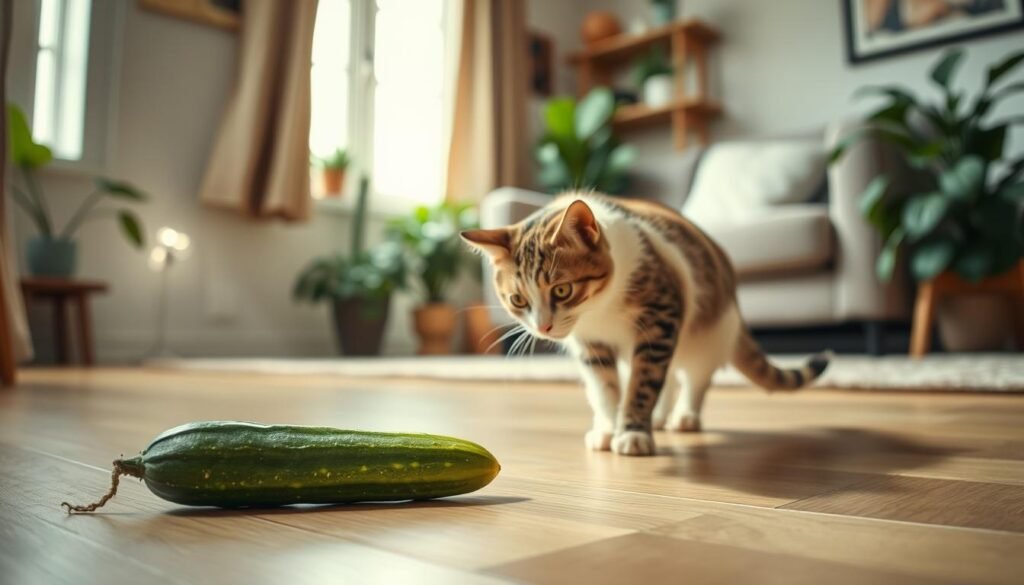
Cat behavior is very complex and tied to their natural instincts. Putting them in scary situations, like with cucumbers, can cause big problems. It can affect their body and mind in lasting ways.
We, as pet owners, must think about the ethical implications of what we do. We should aim to make our cats’ lives happy, healthy, and stress-free. By understanding and meeting their needs, we can help them live well.
Understanding Your Cat’s Unique Personality
Cats are unique, each with their own personality, likes, and quirks. Some cats may be more scared or anxious than others. It’s key for pet owners to respect their cat’s space and build trust.
Respecting Boundaries and Building Trust
Every cat has their own comfort levels and ways of interacting. Respecting your cat’s personal space and boundaries is vital for a good relationship. By moving slowly, letting the cat come to you, and not forcing contact, you can build trust and make a safe space for your cat.
Knowing and meeting your cat’s needs can prevent stress behaviors. Some cats love play and attention, while others like their alone time. Listening to your cat’s signals and adjusting your actions can help you understand their unique personality and individual differences.
“The more you know about your cat’s personality, the better you can cater to their needs and create a bond built on mutual trust and respect.” – Dr. Feline, Veterinary Behaviorist
When to Seek Professional Help
Watching your cat deal with anxiety or behavior issues can be really tough. You might try to make their environment calmer and tackle their fears. But sometimes, it’s best to get professional help.
If your cat shows signs of persistent anxiety, like too much grooming or avoiding things, it’s time to see a vet or animal behaviorist. They can find out why your cat is stressed and create a plan to help.
- Starting with a vet consultation is key to figuring out why your cat acts out. They can check for health problems and suggest treatments.
- At times, your cat might need medicine or therapy to face their fears. A pro can make sure these steps are right for your cat.
If your cat’s anxiety doesn’t get better, don’t wait to seek professional help. Your cat’s health is most important. A specialist can offer the help and support your cat needs to do well.
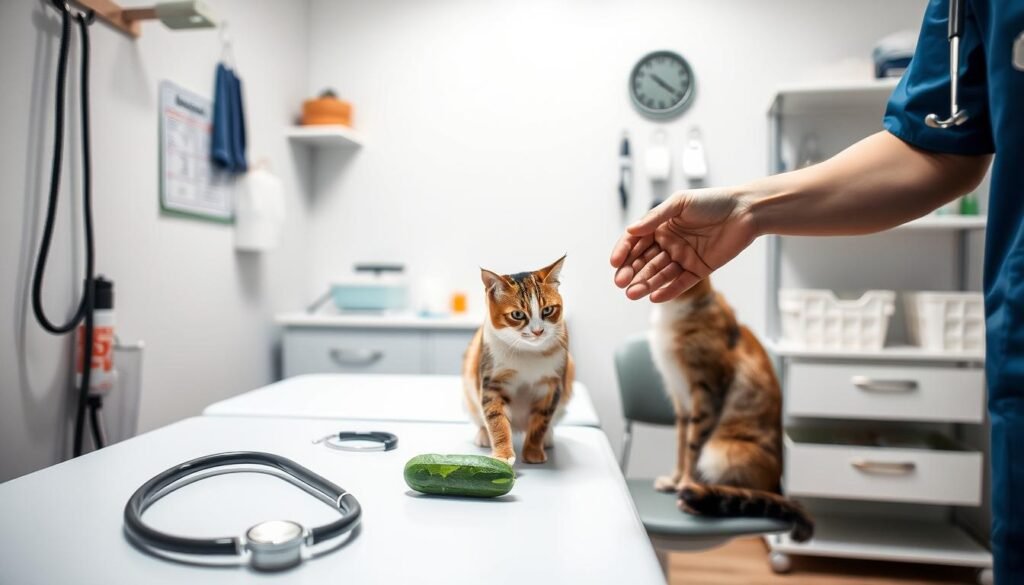
Embracing Your Cat’s Quirks
The cat-cucumber phenomenon might be funny, but remember, every cat is special. They have their own quirks and personality. It’s better to celebrate their uniqueness than to just laugh at it.
Don’t get too caught up in the cat-cucumber trend. Instead, learn about your cat’s unique personality. This will help you connect with them on a deeper level.
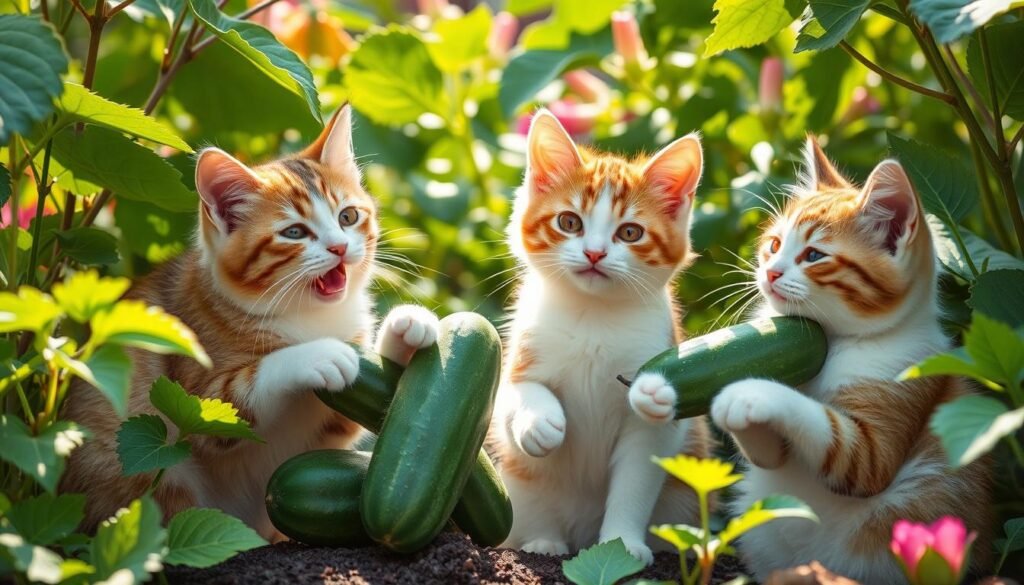
Purr-ting Thoughts
So what’s the deal with cucumbers? Well, it turns out cats can be pretty easily startled. Their natural instincts or past experiences might make them see cucumbers as a threat. But don’t worry, we can help them overcome this fear.
Creating a safe and cozy home for your cat is key. Show them love and attention, and they’ll feel more secure. Understanding their quirky behavior can also strengthen your bond with them.
Let’s celebrate the weird and wonderful world of cats. By learning more about them, we can make their lives happier and healthier.

